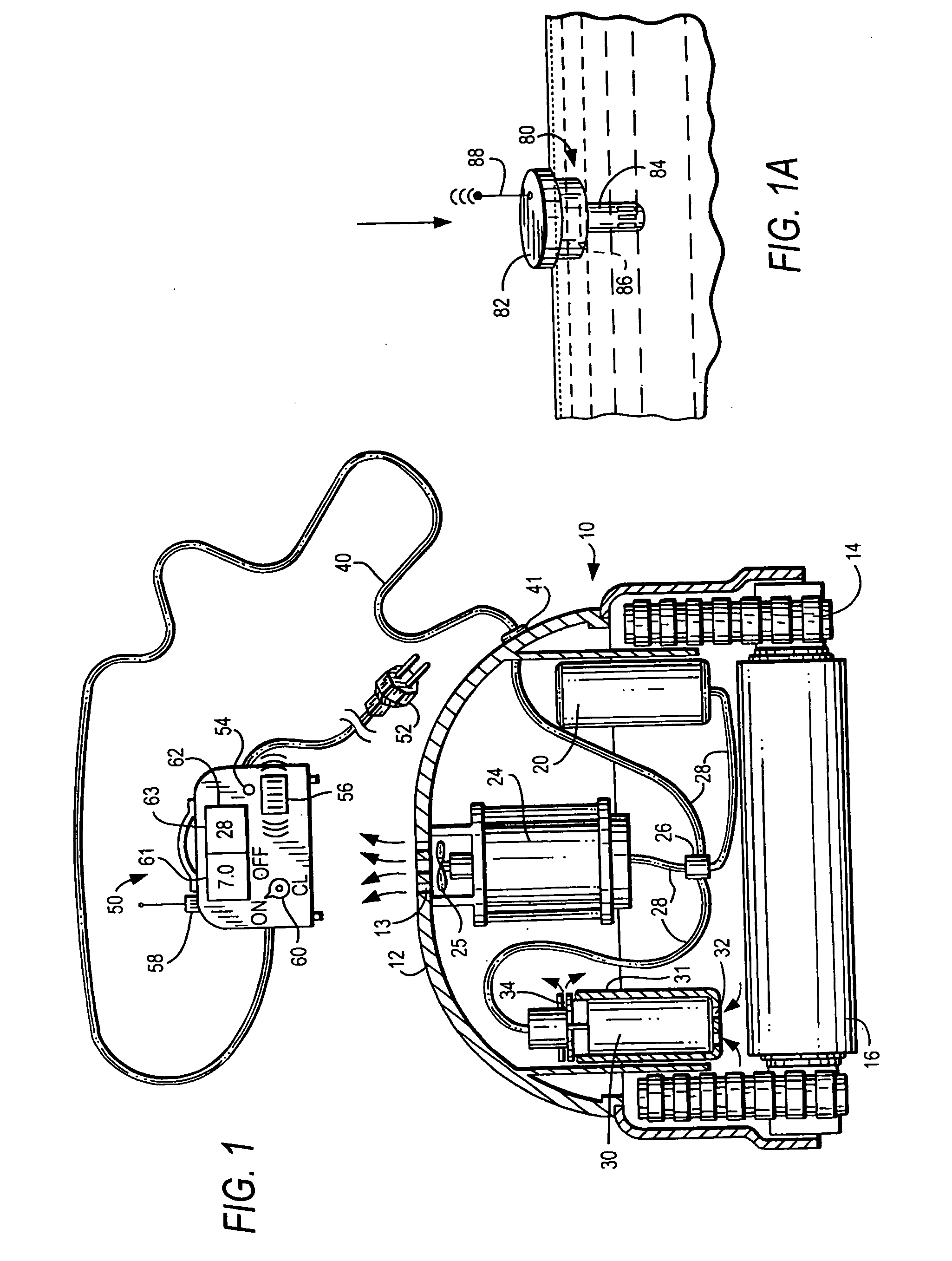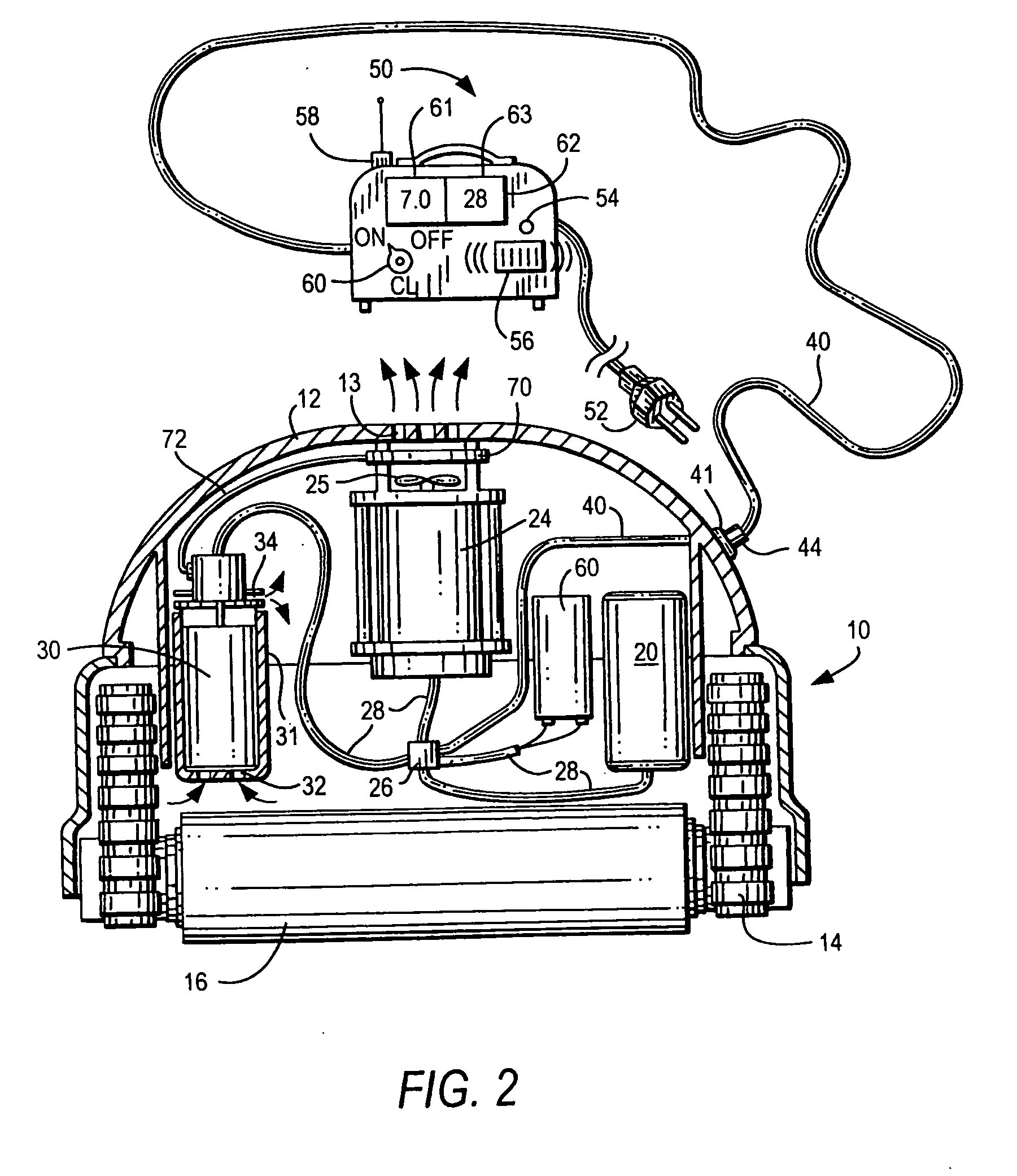[0022]The present invention broadly comprehends an automated self-propelled pool cleaner having a housing, a water pump for moving water through the housing, drive means for moving the pool cleaner over the surface of the
salt water pool to be cleaned and an integral electrochemical chlorine generated mounted in the housing, and includes a processor / controller that is programmed to activate the chlorine generator, the pump and drive means in predetermined operational sequences that minimize
wear and tear on the water pump and drive means, while at the same time distribute and maintain a safe level of sanitizing chlorine in the pool, to thereby obviate the need for an in-line chlorinator or other chemical additive treatments; an optional automated sensor device can be provided to activate a secondary maintenance program which enables the pool cleaner to operate over prolonged periods of time as the sole means for filtering and sanitizing the pool water. A manual mounting
system for the
electrochemical cell permits the
cell to be secured in place for operation and manually removed for maintenance, repair or replacement by the user without special tools or training.
[0032]Among the many advantages of the present invention achieved by combining an automatic pool cleaner with an electrochemical chlorine generator are a more
homogeneous distribution of chlorine, more efficient use of chlorine and reduced or no external pool water pump circulation requirements.
[0046]In accordance with the present invention, a pool cleaner and an electrochemical chlorinator are combined for use as the sole or principal
water circulation and sterilization apparatus and
system for the pool by utilizing a pre-programmed pump
pulse sequence to assure proper functioning of the electrochemical process. The pre-programmed pump
pulse sequence uses very short operational sequences during the pump's
idle time. The operational sequence is programmed so that the time between the pulse pumping is short enough to assure that the
salt solution concentration inside the cleaner does not drop to a hazardously low level. The relatively short time periods of pump operation during the pulse pumping assures that the pump will not suffer a significantly shortened useful life.
[0054]Another technical problem that has been encountered is the formation of scale inside the pool cleaner when the chlorinator operates. The scale formed on the
cell must be removed, since failure to do so will result in scaling so severe that the pool cleaner and / or the chlorinator can malfunction. In a preferred embodiment, ready access is provided to the chlorinator cell. In a particularly preferred embodiment, the cell is provided with a casing that is removable from its operative position inside the pool cleaner housing. The casing can be configured so that it engages a stationary mounting member in a close-fitting, but manually releasable relation. Alternatively, the casing and mounting member are provided with cooperating locking members that permit the casing and cell to be manually removed from the interior of the pool cleaner housing by a user without specialized tools or
technical training. The user can then more easily clean the scale from the cell, e.g., using prescribed chemicals and simple tools in a safe and convenient environment.
[0056]In an especially preferred embodiment of the invention, the unitary case containing the electrochemical chlorine generating cell can be accessed, detached from its mounting bracket(s), removed and returned to its operating position in the pool cleaner by the owner or user, without the assistance of a trained
technician or other specialist. The ability to replace the cell easily and safely with a new or refurbished cell reduces the owner's maintenance and operating costs by avoiding on-site service charges customarily paid for such maintenance. On-site servicing by the user also eliminates the need to take the pool cleaner to a remote
service provider, and the loss of use of the cleaner while waiting for the maintenance to be performed. For the typical residential pool owner, the capability for self-servicing of the pool cleaner's chlorine generating cell will represent a very attractive cost and time-saving feature. As such, it also provides a substantial commercial and competitive
advantage to the manufacturer, marketers and retailers that sell the pool cleaner.
[0061]In another preferred embodiment, a chlorine
monitoring system is for convenience mounted inside the pool cleaner or attached outside to the cleaner. The chlorine
monitoring system can be, for example, an N, N-diethyl-p-
phenylene-
diamine (DPD) based calorimetric system, an amperometric sensor method, or other appropriate device. The chlorine
monitoring system generates electrical signals which are related to the concentration of free chlorine content in the pool water being monitored. The chlorine monitoring system periodically measures free chlorine levels in the pool water and generates signals which are used as the feedback transmitted either directly by hard wired connections, or through a
wireless device to the IC board and computer processor of the pool cleaner controller. The feedback signals are used to control the operation of the
chlorine production of the on-board electrochemical generator mounted inside the cleaner. This automatic chlorine monitoring and production
automatic control system provides a totally automated apparatus and system which does not require frequent human intervention to maintain a constant
residual chlorine level in the pool water and thus minimizes the human attention and also avoids human errors and serves to keep the pool water at its optimum quality.
 Login to View More
Login to View More 


